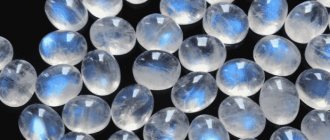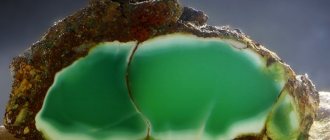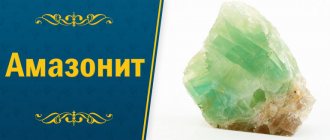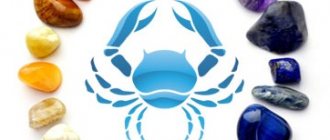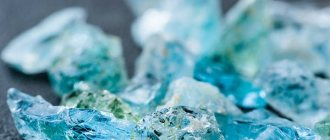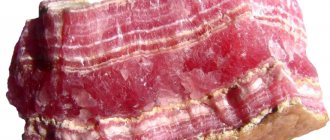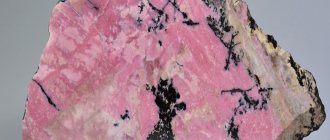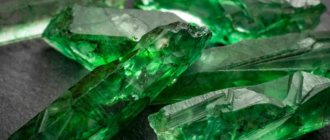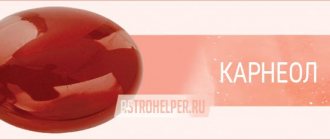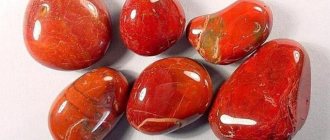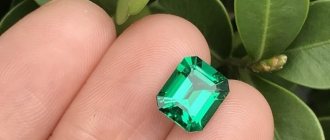Moonstone, also known as selenite and adularia, is a semi-precious, translucent mineral of a gray-milky color, beautifully shimmering in blue, pink, lilac, and white tones. The Hindus gave it the name “jandarakand”, which means “the radiance of the moon”.
Legend says that the exquisite stone appeared when the moon's rays hardened upon reaching the earth's surface. Therefore, it is believed that the adularian receives powerful magical powers from the night luminary.
Varieties and colors
Moonstone is included in the category of feldspars (orthoclases) with the inclusion of potassium. The mineral is characterized by iridescence - the effect of a flickering glow coming from within, due to the presence inside the crystal of thin, stepped plates of albite.
Light refracted when reflected from the surface of the mineral creates pastel blue, pink, lilac, and yellowish tints. Physical and chemical characteristics of the lunar mineral (K[AlSi3O8]):
- hardness – 6.5 Mohs points;
- density – 2.57 g/cm3;
- refraction – 1.525;
- shine – glass;
- transparency – translucent;
- cleavage – perfect;
- fracture – stepwise;
- syngony – monoclinic.
Interesting! If you shine X-rays on the adularia, the stone will luminesce.
There are several varieties of natural lunar mineral:
- Adularia is a translucent milky-white mineral with blue and lilac tints. It has the greatest jewelry value.
- Labradorite is a black variety of stone. The main deposit is located on the North American peninsula of the same name.
- Amazonite is a green mineral.
- Belomorite is a yellowish-white variety with blue tints. The crystal is translucent, the surface is matte. The name is given after the first deposit - the White Sea.
- Sanidine is a blue mineral with a three-dimensional iridescence.
Many-faced gem
All types of minerals, which are commonly called moonstones, belong to the group of feldspars. The difference lies only in the internal structure, which suggests the presence or absence of microcracks, air inclusions, layers growing into each other and other features. Based on these characteristics, in geology it is customary to distinguish orthoclases, oligoclases and plagioclases. What the processed gem looks like depends on its structure.
The magical properties of the moon stone are ensured by its structure: thin plates of crystalline substance pressed together. Regardless of the name, all representatives of this “species” belong to the element of Water, influencing their owner in a very specific way. That is why esotericists do not single out any particular mineral as a real moonstone. The magic of all varieties is of the same nature, differing slightly in the power of manifestation. But in geology, this name refers to only one type of orthoclase - adularia.
Along with similar varieties of natural minerals, synthetic spinel is often passed off as moonstones
In retail outlets, the following minerals may be called lunar:
- Adularia differs from other representatives of its group in the absence of microcracks in the internal structure. This is a rather rare and therefore very valuable gem. Samples of high jewelry quality are mined on the island. Sri Lanka, India, northern Russia (Chukotka, Siberia, Ural). The gem differs from other varieties of moonstone by its blue iridescence (adularization). It is not characterized by rainbow tints or multi-colored flashes. This elegant stone exhibits a single-ray asterism (cat's eye effect) when cut into a cabochon. The ghostly bluish glow is not similar to the glow of other varieties. Only adularia has an amazing, visually three-dimensional crystal depth.
- Rainbow - plagioclase, or white labradorite - is similar in appearance to the previous one, if you do not pay attention to the iridescence. Unlike adularia, it is much less valuable; in its raw form it is almost opaque, white in color with a pearlescent sheen on the fractures. When cut into a cabochon, it is devoid of asterism, but acquires translucency and iridescence with an iridescent tint, reminiscent of gasoline stains on the surface of water. Along with the blue glow, you can see yellowish, pink and purple reflections. When contemplating the stone, there is no feeling of its extraordinary depth, like the adularia.
- From the group of plagioclases, the mineral belomorite was once isolated and given its proper name. Unlike adularia, it iridates in multi-colored small flashes in blue-green and reddish shades. The surface of even a polished sample often has noticeable cracks.
- Labradorite, or black moonstone, has an iridescent blue-green and purple tint to its polished surfaces. People often call it peacock for the similarity of shades of iridescence. Translucent plagioclase is darker in color than other varieties, which makes it possible to distinguish it from other related rocks.
In addition to those listed, the number of gems, as if illuminated by the light of the moon, includes chalcedony, albite, microcline crystals and other types of translucent feldspars. Despite their own beauty, they do not have the effect of iridescence. The jewelry value of such stones is extremely low, and they are used as ornamental stones.
Medicinal properties
Moonstone receives healing powers from the Moon. The celestial body has a healing effect on the nervous system and human psyche. Adularia works similarly; it is used to:
- calm your nerves;
- get rid of phobias and mental disorders;
- weaken epileptic seizures;
- improve brain performance;
- get rid of anger, irritability;
- cure depression, apathy;
- calm a hyperactive child;
- get rid of sleep disturbances and heavy thoughts that prevent you from falling asleep (a stone is placed under the pillow).
Also, the mineral charged with lunar energy has a beneficial effect on the functional state of internal organs containing fluid:
- digestive tract;
- kidney;
- organs of the urinary system;
- liver;
- gallbladder;
- blood vessels.
You should know! Moonstone can have a healing effect even from a distance. You just need to place the crystal on a photograph of a sick person.
How to distinguish a fake from the original
Jasper, chrysoprase and other cheaper minerals are often passed off as gemstones. However, it is quite easy to distinguish them. You need to look at the structure of the sample under a magnifying glass.
In red jadeite it is fibrous-grained with small asbestos and felt-like inclusions. In addition, plastic fakes are often passed off as this mineral.
It is quite easy to distinguish them. Natural stone remains cool for a long time when in contact with human skin. Plastic products heat up quickly.
Magic properties
The magical properties of a stone filled with lunar power are great and varied. He:
- protects against black magical effects;
- speeds up the meeting with your soulmate;
- makes the owner attractive to people of the opposite sex;
- enhances manifestations of tenderness and passion in relationships between lovers;
- prevents betrayal in marital relationships, suppresses the tendency to have affairs;
- warns the owner of danger (changes color);
- makes a person wise, sedate, sensible;
- relieves the blues and thoughts of suicide;
- makes the character balanced, conflict-free;
- ensures success in business and gambling;
- gives the ability to speak and the gift of persuasion;
- promotes the development of creative abilities;
- enhances the desire to perform meaningful and noble deeds.
Mastering macrame: braiding a free-form stone
I am pleased to see how recently more and more wonderful jewelry with braided stones using the macrame technique has appeared.
But what if you really want to weave something like that, but, as if on purpose, you don’t have a suitable cabochon shape and size at hand? Let's try to solve this problem, and today we will learn how to braid a stone of any shape.
This master class is very simple; you don’t even need a pillow for weaving.
Each photo is numbered; The item in the description corresponds to the photo number.
For work we will need:
1. Materials: - the pebble itself (I took a piece of glass to decorate aquariums, “pebbles” made of polymer clay and in general any objects of more or less suitable shape are also suitable); - waxed cord 4 pieces of 80 cm and 1 piece of 50 cm (total 3 m 70 cm), plus a cord for hanging - I have a ready-made thick cord, you can have absolutely any one; - beads No. 5 or 6, with a hole sufficient for a waxed cord; - beads, pendants and all sorts of things suitable for decorating a tassel; — connecting ring (if not, you can do without it); - Moment Crystal glue.
2. Tools: - scissors; - roulette; - an awl or thin crochet hook; - small pliers.
2. Take 4 threads of 80 cm each, put them together and tie a simple knot in the middle, such as in photo 2. All further knots, by the way, will also be simple.
3. Tighten it tightly, if necessary, tighten each thread separately. The ends of the threads are directed downwards; the knot will be the top of our braid.
4. Tie a knot on any pair of threads located next to each other. In this case, we retreat 9-10 mm from the first, central node.
5. Tighten it tightly; We make sure that the distance from the first node does not become too large.
6. On the three remaining pairs of threads we tie the same knots at the same distance from the first knot. This is the first row of our braid.
7. Then we place two knots side by side, take a thread from each and, stepping back another 10 mm, tie a new knot as shown in photo 7.
8. We repeat the same for the neighboring node; Have you noticed that the nodules are arranged in a checkerboard pattern and begin to form a mesh?
9. Continue by adding two more nodes. Now two rows of braid are ready, and the weave is directed downwards.
10. Repeating steps 7-9, weave the third row, exactly the same as the second.
11. You can now try on the braid on the pendant! True, it is still clearly short 
12. My “pebble” expands downward, so I wove the fourth row of braid with an indentation of not 10, but 13 mm.
13. Trying it on again; fits perfectly now.
14. Pull the braid tighter and collect the threads from the underside of the stone. We take an additional 50 cm thread and place it under the braiding threads as shown in photo 14.
15. We wrap 8 strands of braid very tightly with an additional thread; we make 6-8 turns. The braid is always prone to slipping at this stage, so it may be handy to have someone hold the stone while you secure it.
16. Wrapped? Then we tighten the last turn very tightly and firmly tie the two ends of the winding together. To make the knot less noticeable, it is better to place it as close to the stone as possible. We cut these two threads, leaving small ends. It is better to immediately lubricate them with glue so that they do not unravel; If you weave from synthetic threads, you can melt it with a lighter.
17. This is what we got 
18. We will decorate the tassel. To do this, I took gasoline-colored beads and several stray beads from hamster supplies; Any pendants, beads and other things that you want to use are also certainly suitable.
Turn on your imagination We decorate according to the principle: tie a knot, stepping back from the stone from 1 to 2 cm, then string something, secure with another knot; don't forget to tighten it tighter.
We decorate according to the principle: tie a knot, stepping back from the stone from 1 to 2 cm, then string something, secure with another knot; don't forget to tighten it tighter.
19. I got it like this (photo 19).
20. It remains to equip our pendant with a cord; To do this, use a thick awl (a crochet hook will also work) and carefully pry up one of the threads of the first knot.
21. Insert the open connecting ring into the resulting hole, and into the same ring - the suspension thread. If there is no ring, then the suspension thread can be inserted directly into the pendant. But with a ring it will slide better on the suspension.
That's all, our pendant is ready. Here's how it turned out:
————————
Please note that reposting of this master class is permitted and approved by me only if there is an active link to my store.
Partial or complete reprinting, publication, inclusion in collections and other commercial use is possible only with my written permission.
————————
And, of course, I will be very glad to see photos of your creations 
Moonstone and Zodiac Signs
Moonstone's magical properties suit almost all people according to their zodiac sign; it should not be worn only by Aries and Capricorns. Adularia is an ideal talisman for water signs: Cancer, Scorpio, Pisces.
To find out how compatible your zodiac sign is with the energy of the Moon stone, you should look at the table.
Change
| Zodiac sign | Compatibility (“+++” – ideal, “++” – good, “+” – acceptable to wear, “–” – unacceptable to wear) | Influence on the representative of the sign |
| Aries | — | the stone does not combine with the energy of the sign, making a person lazy and lacking initiative |
| Taurus | + | gives confidence and optimism, relieves depression |
| Twins | + | calms, stabilizes emotional state |
| Cancer | +++ | develops oratory, promotes luck and material well-being, relieves anxiety, softens character |
| a lion | + | imparts wisdom and tranquility, helps to choose the right path in life |
| Virgo | + | helps create a strong and prosperous family, imparts wisdom and fortitude, protects from evil, conflicts, black magic |
| Scales | + | guides along the right path in life, helps to overcome obstacles, reveals creative potential, makes life calm and harmonious |
| Scorpion | ++ | eliminates negative character traits, attracts good luck, helps to reveal hidden talents |
| Sagittarius | + | helps in troubleshooting problems and making difficult decisions |
| Capricorn | — | the stone does not fit with the energy of the sign and does not contribute to business and financial success |
| Aquarius | + | relieves stubbornness and other negative personal qualities, protects from evil, envy, black magical influence |
| Fish | ++ | gives peace of mind, promotes the development of talents, attracts luck and wealth, enhances intuition |
Types and variety of shades
The color and type of the lunar gem influence the magical properties, endowing the owner with mystical abilities. Blue stone clears the mind and reveals inner vision, helps to concentrate during relaxation, and to find balance between the masculine and feminine principles. The gem is used by clairvoyants and shamans. The stone opens doors to other worlds and gives the power of the new moon. Grayish minerals help to show talents and encourage the creation of masterpieces.
White stone is closely associated with the beginning of the lunar cycle. Its properties reveal the emotional essence of the individual, daydreaming. Women become liberated, and men become balanced. Children get a restful sleep.
Yellow, pink, peach shades calm the nervous system. The stone relieves anxiety and increases self-esteem.
Black rainbow crystal promotes an even distribution of energy throughout the aura. Its properties help ease difficult experiences, free the mind, and improve sleep. The blue lunar gem is considered a truly valuable and expensive specimen. The magical flickering as it rotates fascinates and enchants. Such minerals are desirable specimens for collectors.
Moonstone for women
Adularia is considered one of the best stones for women. It makes the owner strong, purposeful, but at the same time attractive and interesting. If the wife is quarrelsome and hysterical, then the husband should give her a lunar mineral to correct her bad character.
Adularia is of great benefit to pregnant women. It helps to bear a child without complications and facilitates the birth process.
Healing properties of red jade
Lithotherapists believe that this type of jadeite has pronounced healing properties.
The stone is used to treat:
- chronic and acute kidney inflammation;
- urolithiasis;
- open wounds, burns;
- psoriasis;
- eczema;
- insomnia;
- depression;
- disturbances in the functioning of the pancreas;
- Alzheimer's disease;
- nervous disorders;
- rheumatism, etc.
In addition, contact with the mineral will be beneficial for pregnant women. The energy of the stone helps eliminate swelling and symptoms of toxicosis.
The natural mineral alleviates the symptoms of toxicosis.
Talismans and amulets
Moonstone is an ideal talisman for a person with a core of character, willpower, and the desire to achieve goals. It is recommended to wear a lunar amulet for businessmen, scientists, writers, musicians, artists, performers, and journalists.
If a person suffers from melancholy, is sad, worries for no reason, shows stiffness and confusion, then the lunar mineral will help normalize the emotional state.
Misanthropes, sociopaths, unsociable and aggressive people should not choose adularia as a talisman. The stone will strengthen negative personal qualities. As a talisman, the lunar mineral has several meanings:
- Guardian of love. Gives passion and a romantic mood. Protects feelings from quarrels, betrayals, conflicts, slander. Helps you figure out whether a love relationship is worth continuing. If not, the stone will fade: this is a signal - the relationship will be painful and difficult, it is better to break it off immediately. The glow of the talisman has become more intense - the relationship will be happy and harmonious.
- Revealer of hidden talents. The owner of the stone discovers abilities that he never thought possible. As a result, life changes dramatically for the better. For this to happen, it is recommended to either place a crystal next to your photograph or wear a ring.
- Giver of good luck in financial matters. Helps build trusting and fruitful relationships with partners, conclude profitable contracts, build a career, have a successful start in business, improve your financial situation, and get out of debt. To achieve these goals, the adularia should be worn in the form of a pendant, bracelet or ring on the finger of the right hand.
- Amulet for the traveler. Protects against troubles along the way. The talisman becomes as strong as possible during the full moon. It is not advisable to wear it on new moon days, as there is a high probability of energy exhaustion and loss of tone.
Jade in China
In China, this stone is considered national. They say that it shows the essence of a person, his body and soul. A sharply darkened stone means that its owner has committed many sins. In Ancient China, it was valued more than gold and could only be worn by a select few. The mineral personified immortality, power and strength.
Chinese philosophers say that different types of this stone have different effects on the essence of a person. Some represent mercy, others wisdom and honesty. A famous Chinese proverb says: “All gold has its price, but jade is priceless.”
Descriptions of the mineral can be found in the works of Confucius and other famous Chinese philosophers. There are other famous sayings associated with this divine gift of nature:
- “An unpolished stone does not sparkle.”
- "He's as pure as jade."
Jade jewelry began to be made in the Middle Kingdom 7,000 years ago. Most often it was used in magic for sacred rituals. It was minimally processed. Round disks made of yellow stones represented the Earth, blue ones - the Sky.
The most famous varieties of jade in China are called Khotan and Xiuyan.
How to wear and care
If the moonstone is perceived not only as a decoration, but also as a talisman, then it is better to set it in silver. Other metals will inhibit the magical properties of the mineral.
The effectiveness of a lunar talisman is greater if it is worn so that it comes into contact with the skin. If the product is not suitable for wearing close to the body, then you need to pick it up several times a day to receive a portion of positive energy from the moon crystal.
The magical properties of the mineral gradually weaken. To restore them, it is necessary to carry out energy cleansing every week. To do this, wash the stone in running water and leave it overnight on a windowsill under the moonlight. In order for the lunar talisman to serve for a long time, you should properly care for it:
- protect from direct sun;
- do not expose to high temperatures or chemicals;
- do not drop;
- clean with soapy water, wipe with a soft cloth;
- do not use household and hygienic chemicals or hard bristled brushes for cleaning;
- Store in a separate box with soft inner walls.
Moonstone is an unusually beautiful gift from nature, valued in jewelry for its soft and deep multi-colored tints. This is not only an exquisite decoration, suitable for both women and men of all ages, but also a strong talisman that corrects character traits and helps in career, love, and creativity.
Known gem deposits
From ancient times to the present day, it is believed that the most beautiful adularia are mined in Myanmar and Ceylon (now Sri Lanka). This is where the most expensive varieties with bluish iridescence and a three-dimensional effect come from. The mineral is located in the thickness of volcanic rocks, where it crystallized millions of years ago from a melt of silicon and other substances.
A large amount of adularia is mined in Russia. Domestic samples are famous for their inclusions of gold and silver nanoparticles. This provides an unusual play of light in the crystal, although it does not cause the flickering characteristic of belomorite.
This variety also belongs to the Russian variety. A deposit of belomorite was discovered at the beginning of the twentieth century in Karelia. Geologists accidentally noticed an outcropping of light-colored rock with an unusual pearlescent tint. It is believed that only a poetic description of this oligoclase allowed it to receive its own name.
Labradorites are found both in the Russian North and on the American continent, where they have been mined for more than a century. Rainbow tints made peacock stone very popular among urban fashionistas back in the 19th century. The relatively low cost of the stone makes jewelry with it quite affordable in price.
The calming cold shine, akin to moonlight, makes the gem desirable for many representatives of the fair sex. But we should not forget that its magical properties and energy may conflict with the character of the owner. A beautiful piece with iridescent or shimmering precious adularia or iridescent labradorite can bring more than just joy. When choosing a moonstone for yourself, you need to take into account some subtleties, and then you will not have to regret the money spent on its purchase.
Location
Every time Red Mountain erupts, a few of them fall somewhere around here. Look for small craters, rocks sticking out of the ground, things like that. It may not be easy to remove the heart stone, but you seem... strong enough. Good luck - Neloth
Heart Stone can be obtained by mining from deposits located in Solstheim. Deposits can be mined using a regular pickaxe, just like ore veins. There are 28 deposits, each of which can yield three heart stones. Like ore veins, heartstone deposits regenerate over time.
History of the appearance of ore
The Heart Stone in Skyrim, on the island of Solstheim, appeared as a result of the volcanic eruption of Red Mountain, which occurred two hundred years before the plot events of the add-on. Local residents called this period the Red Year.
They believe that this breed was near the Heart of Lorkhan. It is for this reason that heart stones, even after two centuries, are still able to glow with the heat of the Red Mountain.
Additional information about the disaster on the mountain can be read in the books that are on the shelves of the island's residents.
Description
Heart stone
- an unusual type of ore mined from deposits that appeared on Solstheim in the Fourth Era.
Presumably, deposits of these stones were formed during the cataclysms that occurred in the Red Year. Master Neloth of House Telvanni believes that the heartstones are molten pieces of rock from the depths of Red Mountain, thrown out along with the stones and ash during the eruption. Even 200 years later, they still glow with the heat of the mountain. These are molten pieces of rock that have lain near the Heart of Lorkhan for millennia and, apparently, some of its power was transferred to them. Heartstones sometimes create ash spawns from bone fragments buried in the ash nearby.
During the dissection of the Spriggans, Neloth came to the conclusion that the heart stone implanted in the chest was capable of imparting enormous powers. He wanted to replace his own heart with a heart stone, but Ildari Sarotril, his student, suggested that he operate on her first. Ildari died during the experiment, but was brought back to life thanks to the action of the heart stone implanted in her. Ildari discovered that the heart stone could be used to prevent the effects of necromancy spells.
Through trial and error, one of Neloth's students found out that the heart stone is necessary for the spell “Summon Ash Guardian", Without which the summoned creature will attack everyone it sees, including the caster. In addition, heart stones are used to enchant staves.
You can save the life of a cowardly hillbilly. Or not to save
By installing the Dawnguard DLC and joining the ranks of the Vampire Hunters, players will be able to stumble upon a new random encounter. It is most often found in the area around Whiterun. Hakar, a Dawnguard recruit like you, will fight two vampires. They are much stronger, so you can help him. After this, Khakar will lay out all the Guard’s equipment and weapons in front of Dovahkiin, thank him for his help and run away. And if you watch the guy get killed, you can later take the note from his body.
Here are Izran’s kindest words to Hakar: “You constantly fail assigned tasks and disgrace the entire order. Are you really that stupid that you can’t complete even the simplest delivery order?” After this, you will find out where the Guard's caches are, and you will be able to pick up loot from them.
